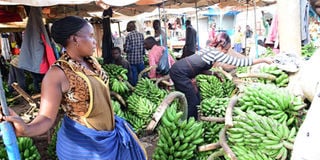Inflation kept in check in 2018

Prices of food crops such as Matooke remained low thus keeping down inflationary pressures in 2018. PHOTO BY EDGAR R BATTE
What you need to know:
Below target. Inflation was in 2018 kept in check remaining below the 5 per cent Central Bank target, according to data from Uganda Bureau of Standards
The good weather experienced in the last 12 months ensured that inflation is kept in check at an average of 2.6 per cent.
This was lower compared to 5.6 per cent that was registered in 2017.
Lower inflation meant that Ugandans were saved from near to impossible prices of goods and services.
This, in the same measure, encouraged private investments, especially in the food sector where lower prices were recorded in the period.
According to data from Uganda Bureau of Statistics (Ubos), annual headline inflation for 2018 stood at 2.6 per cent.
Annual food crop inflation, according to Ubos was registered at -1.5 per cent for the period compared to 13 per cent registered in 2017
While releasing the consumer price index for 2018 in Kampala on Monday, Dr Chris Mukiza, the Ubos director for macroeconomic statistics, said there was increased supply of food crops in the market, which largely contributed to lower inflation rate.
“There was enough to purchase food items with the same amount of money compared to the previous year. Matooke, Irish potatoes, tomatoes, maize flour, sugar among other food items had lower prices compared to last year [2017],” he said.
However, Dr Mukiza said, while consumers experienced lower prices for food, farmers registered low income arising from low market value for most agricultural produce.
Core inflation, which Bank of Uganda uses to control inflationary pressures, stood at 2.4 per cent in 2018 compared to 4.4 per cent registered during 2017.
Below target
This was way below the Central Bank’s 5 per cent inflation target.
Ubos data also indicated that annual average Energy Fuel and Utilities (EFU) inflation rose to 10.7 per cent during 2018 compared to 7.5 per cent recorded in 2017.
Ubos blamed the increase on prices of water, electricity, fuel, charcoal and firewood during the period.
In its recent monetary policy committee meeting, the Central Bank said inflation outlook remained relatively unchanged from the previous forecast on account of less depreciation of the exchange rate market.
The Central Bank said core and headline inflation will be lower by 1 percentage point and 0.7 percentage point respectively to about 6.6 per cent and 5.1 per cent in the 2019 second quarter.
Inflation at continental level
At the continental level, the World Bank said in its Africa Pulse report released in October that inflation has eased across the region in 2018, due to falling food prices and the slow pace of currency depreciation in many countries.
The World Bank said currencies in the region depreciated amid tighter global financing conditions, strengthened US dollar and falling investor sentiment toward emerging markets.
“Median annual inflation in the region is estimated to have declined from 5.2 per cent in 2017 to 4.6 per cent in 2018. The number of countries with two-digit inflation decreased. Among oil exporters, inflation fell in Nigeria and Angola, although it remained in double digits,” said the World Bank.




